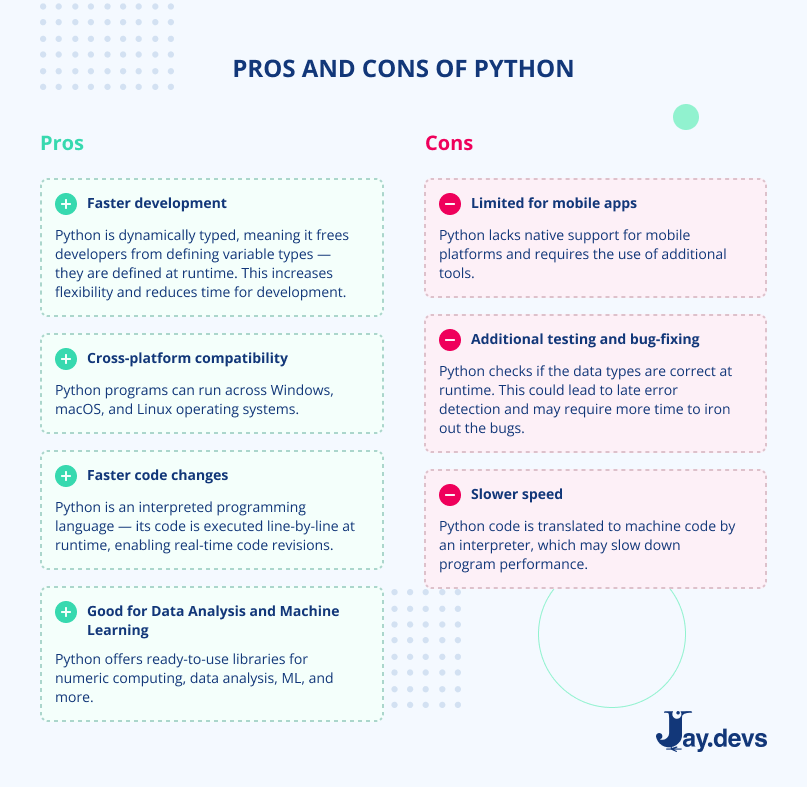**Pros and Cons of Python for Data Analysis** Python offers extensive libraries and ease of use for data analysis. It may struggle with speed and memory usage.
Python has become a popular choice for data analysis due to its simplicity and powerful libraries. Libraries like Pandas, NumPy, and Matplotlib make data manipulation and visualization straightforward. Python’s readability and community support enhance its appeal for both beginners and experts.
Despite these advantages, Python may not be the best for high-performance tasks due to its slower execution speed compared to languages like C++. Memory management can also be a challenge with large datasets. Overall, Python’s strengths in ease of use and library support often outweigh these drawbacks for many data analysts.
Introduction To Python In Data Analysis
Python is very popular. Many people in tech use it. It is easy to learn. Kids can learn it too. Python has many libraries. Libraries help in data analysis.
Pandas and NumPy are famous libraries. They make data work easy. Many companies use Python. It is common in data science. Python is also free. You don’t pay to use it.
Python is important for data work. It helps in making reports. Many industries use these reports. Python can handle big data. It works well with other tools.
Python helps in automation. It saves time. Many tasks become easy. Python also supports machine learning. It helps in making smart systems.
Ease Of Learning Python
Python has a simple and clear syntax. This makes it easy for beginners. Many find it easier to read than other languages. Its code looks like plain English. So, even kids can understand it. This lowers the entry barrier for new learners. Python avoids complex symbols. This keeps the code clean and easy to follow.
There are many resources to learn Python. You can find online tutorials, books, and courses. Many of these resources are free. Community support is also strong. Forums and groups help you solve problems quickly. Websites like Stack Overflow are full of useful answers. This makes learning Python even easier.
Rich Ecosystem Of Libraries And Frameworks
Python offers many critical data analysis packages. Pandas helps in data manipulation and analysis. NumPy provides support for large multi-dimensional arrays. Matplotlib is essential for data visualization. SciPy is useful for scientific and technical computing. Scikit-learn is great for machine learning tasks.
Python integrates well with other tools. Jupyter Notebooks allow interactive data analysis. SQLAlchemy helps in database manipulation. TensorFlow and PyTorch integrate for deep learning. Apache Spark works well with PySpark for big data.

Credit: www.valuecoders.com
Python’s Flexibility And Versatility
Python is used in many fields. It is popular in web development, artificial intelligence, and data analysis. Python is easy to learn and use. This makes it a favorite among beginners and experts.
The language has a vast collection of libraries. These libraries help in performing various tasks. For data analysis, libraries like Pandas and NumPy are very useful. They make handling large datasets easier.
Applications Across Various Domains
Python is not limited to one field. It is used in finance for predicting stock prices. It helps in healthcare for diagnosing diseases. Python is also used in marketing for analyzing customer data.
This versatility makes it a powerful tool. It can adapt to various needs and requirements. Python’s community is large and helpful. This ensures continuous improvement and support.
Adaptability To New Challenges
Python can handle new tasks easily. Its syntax is simple and clear. This makes writing and reading code easier. Python can be integrated with other languages. This adds to its flexibility.
New libraries and tools are developed regularly. This keeps Python up-to-date with new challenges. Python’s adaptability makes it a preferred choice for many developers.
Performance Considerations
Python is often slower than other languages. C++ and Java are usually faster. They handle tasks more quickly. Python’s interpreted nature causes delays. This can be an issue for some projects. Compiled languages like C++ run faster because they convert code into machine language.
Python can handle large datasets well. Libraries like Pandas and NumPy help with this. They provide efficient tools for data manipulation. Python’s memory management can be a concern with very large datasets. Sometimes, it uses more memory than other languages. Optimized libraries can help reduce memory usage.

Credit: www.ideamotive.co
Python’s Limitations In Data Analysis
Python can use a lot of memory. This can slow down your computer. Large datasets make this worse. Python is an interpreted language, which means it is not as fast as compiled languages. This can be a problem for data analysis. Memory management in Python can be tricky. You might need to use special tools to help.
Python has global interpreter lock (GIL). This makes it hard to run multiple tasks at once. Concurrency can be a problem in data analysis. You may need to use workarounds like multiprocessing. These workarounds can be complex. They might also not solve all problems. For real-time data, this can be a big issue.
Community Support And Collaboration
Python has a strong community. People share their knowledge and help others. Many forums exist for Python discussions. Stack Overflow is very popular. Users can ask questions and get answers fast. Reddit also has active Python groups. These platforms are very helpful for beginners. Many experts participate and share tips. The community is welcoming and inclusive.
Python is open-source. Many people contribute to its development. GitHub is a popular platform for this. Users can find many Python projects there. They can contribute to these projects. This helps in learning and skill improvement. Contributing to open-source projects builds a strong resume. It also helps in building a professional network. Many companies value open-source contributions.
Real-world Case Studies
Python helped Netflix predict user preferences. They improved their recommendation system with Python. Spotify uses Python for data analysis too. It helps them understand music trends. Python also powers Google’s search algorithms. This makes searches faster and more accurate.
Python can handle large datasets. It makes data cleaning easy. Python’s libraries like Pandas and NumPy are powerful. They simplify complex tasks. Python is flexible and easy to learn. Many companies prefer it for data analysis.
Choosing The Right Tool For Data Analysis
Python is popular for data analysis. It has many libraries like Pandas and NumPy. These libraries make it easy to work with data. R is another popular tool. It is great for statistics and visualization. Excel is also used often. It is simple and good for small datasets. Each tool has its own strengths and weaknesses.
| Factor | Python | R | Excel |
|---|---|---|---|
| Ease of Use | Medium | Medium | High |
| Data Size | Large | Large | Small |
| Libraries | Many | Many | Few |
| Visualization | Good | Excellent | Basic |
Future Of Python In Data Science
Python is growing fast in data science. New libraries are coming out often. Data scientists love Python’s simplicity and power. Machine learning and deep learning are big trends. Python has tools like TensorFlow and PyTorch for these. These tools help in building smart models.
Big data is another trend. Python can handle big data well. Libraries like Dask and PySpark help with this. Automation is also on the rise. Python scripts can automate many tasks in data analysis. This saves time and reduces errors.
Cloud computing is becoming important too. Python works well with cloud platforms. It helps in scaling data analysis tasks. Python’s community is also growing. This means more support and more tools.

Credit: jaydevs.com
Frequently Asked Questions
What Are The Advantages Of Python In Data Analysis?
Python offers simplicity, flexibility, and a rich ecosystem for data analysis. Libraries like Pandas and NumPy streamline data manipulation. Visualization tools like Matplotlib and Seaborn create insightful graphs. Python’s community support ensures continuous improvements and abundant resources. It integrates well with other tools, enhancing productivity and efficiency in data analysis.
What Are Python Pros And Cons?
Python offers easy syntax, vast libraries, and strong community support. It suits beginners and rapid development. However, it runs slower than compiled languages and isn’t ideal for mobile app development.
Is Python Or R Better For Data Analysis?
Python and R both excel in data analysis. Python is versatile and integrates well with other software. R specializes in statistical analysis and visualization. Choose Python for general-purpose tasks and R for in-depth statistical work.
Is Data Analysis With Python In Demand?
Yes, data analysis with Python is in high demand. Many industries seek Python skills for data analysis. Companies value Python for its versatility and efficiency.
Conclusion
Python for data analysis has clear advantages and disadvantages. Its simplicity and versatility make it popular. However, performance issues can arise with large datasets. Choosing Python depends on your specific needs and project requirements. Carefully weigh the pros and cons to make an informed decision.

